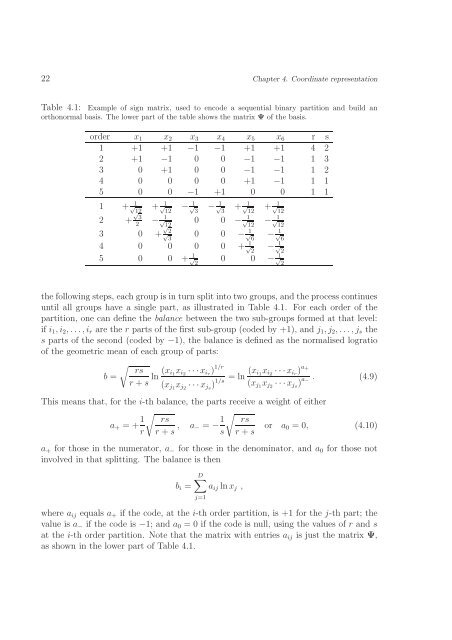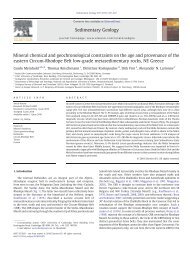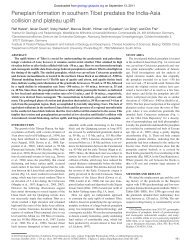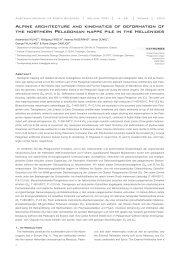Lecture Notes on Compositional Data Analysis - Sedimentology ...
Lecture Notes on Compositional Data Analysis - Sedimentology ...
Lecture Notes on Compositional Data Analysis - Sedimentology ...
You also want an ePaper? Increase the reach of your titles
YUMPU automatically turns print PDFs into web optimized ePapers that Google loves.
22 Chapter 4. Coordinate representati<strong>on</strong><br />
Table 4.1: Example of sign matrix, used to encode a sequential binary partiti<strong>on</strong> and build an<br />
orth<strong>on</strong>ormal basis. The lower part of the table shows the matrix Ψ of the basis.<br />
order x 1 x 2 x 3 x 4 x 5 x 6 r s<br />
1 +1 +1 −1 −1 +1 +1 4 2<br />
2 +1 −1 0 0 −1 −1 1 3<br />
3 0 +1 0 0 −1 −1 1 2<br />
4 0 0 0 0 +1 −1 1 1<br />
5 0 0 −1 +1 0 0 1 1<br />
1 + 1 √<br />
12<br />
+ 1 √<br />
12<br />
− 1 √<br />
3<br />
− 1 √<br />
3<br />
+ 1 √<br />
12<br />
+ 1 √<br />
12<br />
2 + √ 3<br />
2<br />
− 1 √<br />
12<br />
0 0 − 1 √<br />
12<br />
− 1 √<br />
12<br />
3 0 + √ 2 √<br />
3<br />
0 0 − 1 √<br />
6<br />
− 1 √<br />
6<br />
4 0 0 0 0 + √ 1 2<br />
− √ 1<br />
2<br />
5 0 0 + √ 1 2<br />
0 0 − √ 1<br />
2<br />
the following steps, each group is in turn split into two groups, and the process c<strong>on</strong>tinues<br />
until all groups have a single part, as illustrated in Table 4.1. For each order of the<br />
partiti<strong>on</strong>, <strong>on</strong>e can define the balance between the two sub-groups formed at that level:<br />
if i 1 , i 2 , . . .,i r are the r parts of the first sub-group (coded by +1), and j 1 , j 2 , . . .,j s the<br />
s parts of the sec<strong>on</strong>d (coded by −1), the balance is defined as the normalised logratio<br />
of the geometric mean of each group of parts:<br />
√ rs<br />
b =<br />
r + s ln (x i 1<br />
x i2 · · ·x ir ) 1/r<br />
(x j1 x j2 · · ·x js ) = ln (x i 1<br />
x i2 · · ·x ir ) a +<br />
1/s (x j1 x j2 · · ·x js ) a . (4.9)<br />
−<br />
This means that, for the i-th balance, the parts receive a weight of either<br />
a + = + 1 √ rs<br />
r r + s , a − = − 1 √ rs<br />
or a 0 = 0, (4.10)<br />
s r + s<br />
a + for those in the numerator, a − for those in the denominator, and a 0 for those not<br />
involved in that splitting. The balance is then<br />
b i =<br />
D∑<br />
a ij ln x j ,<br />
j=1<br />
where a ij equals a + if the code, at the i-th order partiti<strong>on</strong>, is +1 for the j-th part; the<br />
value is a − if the code is −1; and a 0 = 0 if the code is null, using the values of r and s<br />
at the i-th order partiti<strong>on</strong>. Note that the matrix with entries a ij is just the matrix Ψ,<br />
as shown in the lower part of Table 4.1.









